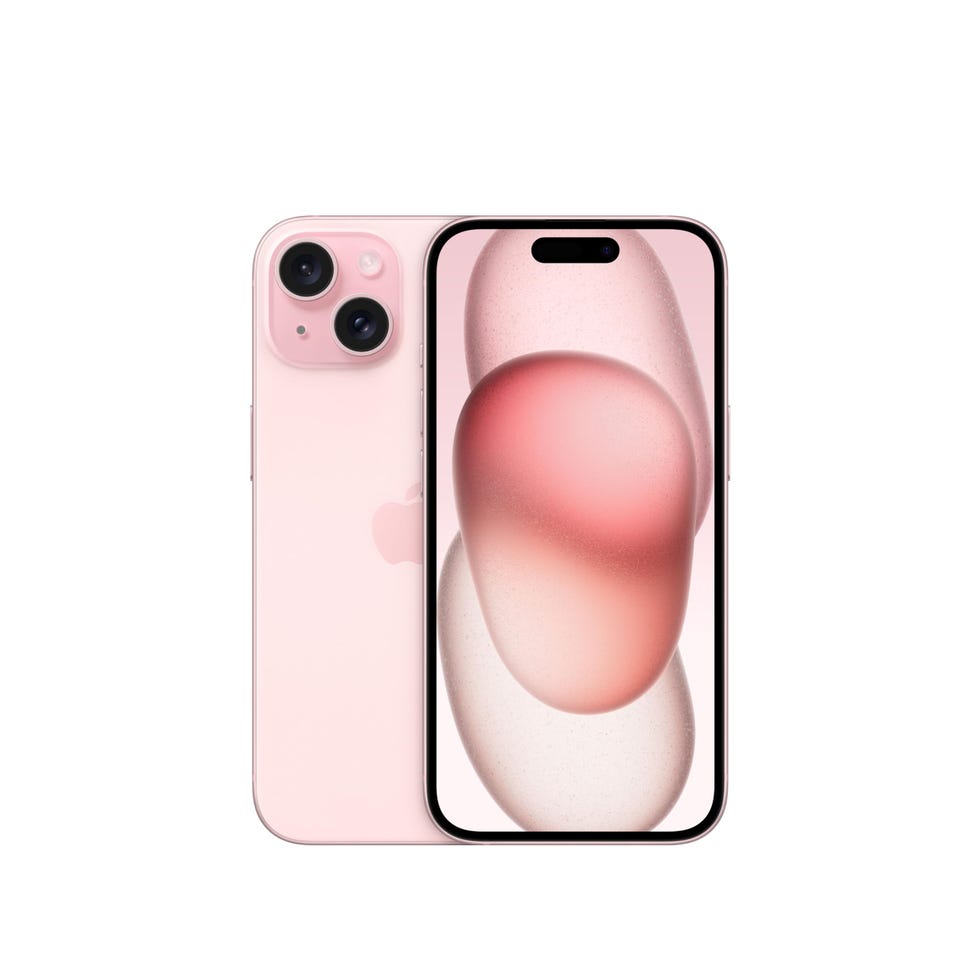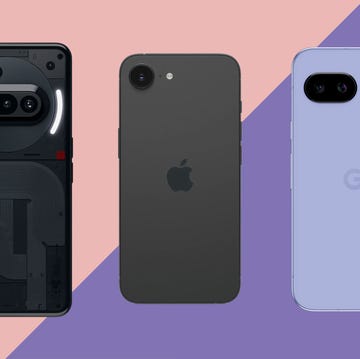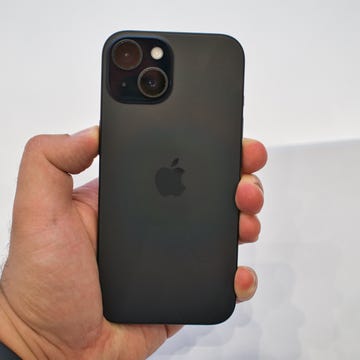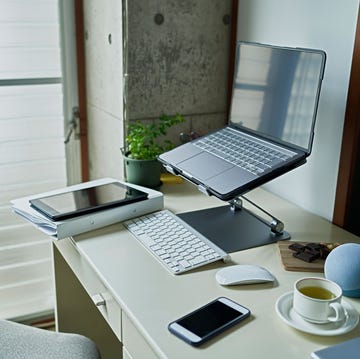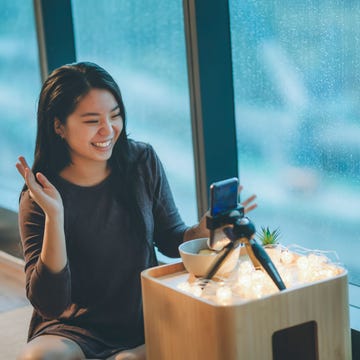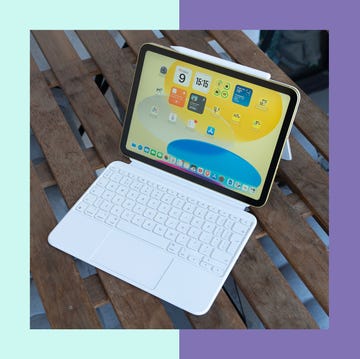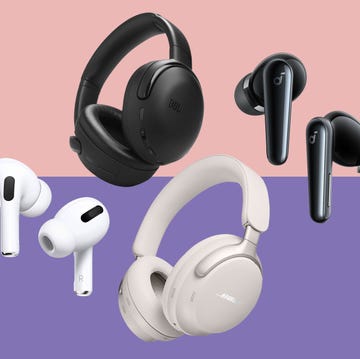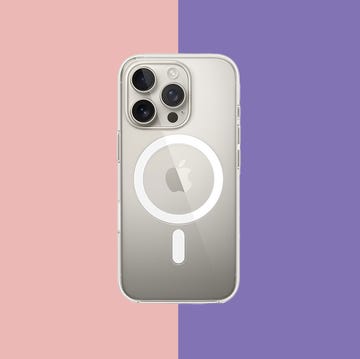At about this time every year, like clockwork, Apple unveils new iPhones. But do you need to rush out and upgrade to the best iPhone just because there’s a new one available? And what is the iPhone 15 really like to use? Here at Good Housekeeping, I’ve been lucky enough to get my hands on the new iPhone 15 models – including the pricier 15 Pro and Pro Max – and I'm here to explain what’s changed and if you should consider getting a new handset in 2023.
For most of us, a potential upgrade means looking at the standard lineup, and the good news is that (unlike last year’s iPhone 14) there’s a lot to appreciate in the main iPhone 15 and its slightly larger sibling, the 15 Plus. And they’re launching at better value prices than they did last September too – that’s a welcome surprise for shoppers in the UK.
What’s new in the iPhone 15 and iPhone 15 Plus?
There are a few things that are the same when you’re comparing the iPhone 15 and iPhone 14 models: they come with the same screen size options, the same storage options, and the same battery sizes. But where they differ is with the previously Pro-level features that are now on the standard iPhone models.
You’ll now get the smart “Dynamic Island” at the top of the display (more on that below), a powerful A16 chip to deliver faster speeds and improved multitasking, new colour options (hello, pink iPhones!), a significantly upgraded 48-megapixel camera system and a versatile USB-C port. The Pro models get a smart new customisable “action button” in place of the mute switch, but this is unfortunately absent on the standard models. Overall, though, there’s a lot to like with the normal 15. And, while they still look like iPhones, they’re also slightly redesigned with contoured edges that are far more comfortable to hold and don’t feel slippery.
iPhone 15: Key specifications
- Screen size and resolution: 6.1-inch, 2556 x 1179 pixels for iPhone 15; 6.7-inch, 2796 x 1290 pixels for iPhone 15 Plus
- Cameras: 48MP main, 12MP ultra-wide, 12MP 2x telephoto, 12MP front-facing
- Battery life: Up to 20 hours for iPhone 15; Up to 26 hours for iPhone 15 Plus
- Storage: 128GB, 256GB, 512GB
- Weight: 171g for iPhone 15; 201g for iPhone 15 Plus
- Water resistance: Yes, IP68
iPhone 15: Display
As most people now wait a few years between switching devices, though, it doesn’t always make sense to only compare to last year’s model. If you’re coming to this from an older model with an LCD display like the iPhone SE, XR or 11, you’ll immediately notice a massive difference with the iPhone 15’s crisp OLED panel.
Don’t worry too much about the terminology, what you need to know is that you’ll get far better vibrancy, contrast and colours. And, with the iPhone 15, you’ll find that it gets brighter right when you need it to, with three times more brightness in outdoor conditions than the iPhone 12. This is especially useful when you’re trying to read texts in the sunlight, and on test, I'm as impressed by this as I was with the same capability on the 14 Pro. Unfortunately, though, there’s no always-on display here, and that’s a feature we love in the Pro lineup.
There’s also now the “Dynamic Island” feature present at the top of the display. I know what you’re thinking, what “island”? What this term refers to is the portion of the screen used for the front-facing camera and facial recognition sensors, that little pill-shaped bit at the top.
Apple has added functionality to the display in this area so that you can see background information at a glance, this includes “live activities” and the music or podcasts you’re playing. It’s invaluable when following your timer progress, directions in a mapping app, quickly seeing which song is on, getting travel updates (like when to head to your gate at the airport), or the latest updates on your Uber arrival.
iPhone 15: Camera
If you’re asked what the most important element of a smartphone is, I wouldn’t be surprised if you said it’s the camera. And I’d agree. I love to take photos on dedicated cameras, but my iPhone is easily my most used camera, for everything from landscapes and travel shots to portraits, pet photos and snaps of my morning coffee. All of us use our phone cameras every single day, and that’s why it’s such great news that Apple has brought all its major camera changes from last year’s Pro lineup to the iPhone 15. That means big high-resolution images that take up a fraction of the room you’d expect, far better low-light shots and an overhaul of the way you can shoot stunning portraits.
Immediately, the 48-megapixel (MP) main camera on the iPhone 15 feels like a big step forward, and its capabilities match that of what you’d expect from a high-end shooter. I’ve used it to snap away portraits, architectural shots and scenes at night, and I’ve found that the iPhone’s computational photography does a brilliant job at reproducing the moment in the way I remember it, without it oversaturating or brightening everything up too much.
Apple’s system has had a heavy hand in the past, but so far it feels just right here. You can turn on amazing full 48MP mode in great lighting, but the typical 24MP shots look fantastic by default. The bigger sensor also brings a 2x optical zoom to the iPhone 15. This uses the centre portion of the image recorder to deliver high-quality close-ups – I think it’s especially great for portraits.
Speaking of portraits, Apple has changed a lot about its portrait photography system. It’s now automatic, so you don’t need to worry about turning it on in advance to get a soft background blur behind people in your photos. When you go to edit, the Photos app allows you to turn photos with people, cats or dogs into portraits, giving you the flexibility to change the focus point after you’ve taken the photo too. In my tests, this works every time with pictures of people but isn’t quite as reliable with animal photos yet. When it works, though, it’s remarkable. I'll be taking many more portraits that I’d have missed by forgetting to turn this mode on.
Below, I've included a gallery of photos I've taken on the iPhone 15. They’re all unedited to show you the colour treatment and contrast you can expect to get out of this brilliant camera system.
iPhone 15: Battery
Now that I’ve used the iPhone 15 for a couple of weeks, I can confirm that there’s no cause for alarm when it comes to the battery life. It’s not any worse or better than its predecessor and will give you about the same amount of screen-on time.
Apple states the same claimed battery life as offered by the iPhone 14 models, going up to 20 hours of video playback on the standard iPhone 15 and up to 26 hours of video playback on the iPhone 15 Plus. In my testing, this feels accurate, as it can get us through right to the end of the day before needing to go on the charger overnight.
The one thing I do still think is important to note is that, if you’re about to invest in the more expensive iPhone 15 Pro Max primarily for its bigger battery, I’d suggest considering the iPhone 15 Plus. Apple claims it’s better for battery longevity in some circumstances (like how it’ll last for 100 hours of audio playback, compared to the Pro Max’s 95 hours) and, in regular use, it should match the battery performance of the flagship.
While the stated battery life is unchanged, there’ll be some extra efficiency and speed due to the inclusion of the A16 Bionic processor from last year’s Pros. Don’t worry if you don’t know what exactly the processor does, it’s powering those new features like the Dynamic Island and the new 48MP camera. I can already tell it’s faster than the already great chip in the iPhone 14, and I’ve used this A16 Bionic for the past year in the iPhone 14 Pro so can attest that it handles everything I throw at it.
iPhone 15: USB-C
This inclusion is one I’ve been waiting for, and while some Android users may be unimpressed, I've got to say that I'm delighted to see a more standard charging port now available on the iPhone. I know longtime iPhone users will be understandably puzzled but this is a change that I'd applaud. Most new tech gadgets in 2023 charge with USB-C, so you’ll find this is likely the same port you already use to charge your earbuds, headphones, laptop, iPad, Kindle and much more, and that means that your new iPhone is already compatible with the cables all around your house.
Now, the question you’ll want to ask is whether you already have a USB-C adapter or whether you need to buy one. Remember, smartphones don’t tend to include the plug in the box anymore. With the iPhone 15, you’ll be getting a lovely fabric USB-C to USB-C cable, so one of the first things to do is to check if you have an existing mains adapter to connect it to.
If you don’t, you’ll want to get it into a USB-C wall plug like this Apple one or Anker’s alternative – both have neat folding prongs that make them easy to store when travelling. This USB-C port can also charge accessories like AirPods and an Apple Watch from the phone’s battery, but the only downside is that Apple reserves its fast data transfer speeds for the Pro-series iPhones.
iPhone 15: Software
The new iPhone 15 models come with the latest software. That’s iOS 17, which is also available to users of much older handsets going back to those as old as 2018’s now-discontinued iPhone XR. I'm fans of the mostly incremental changes that you can see in Safari, Messages, on the customisable lock screen (you can now tweak your clock’s font weight, for instance) and with AirDrop and NameDrop for sharing files and contact information for other iPhone users.
There’s also the new StandBy Mode, which effectively turns your iPhone into a little smart display when it’s charging and horizontal (this works best on a MagSafe-enabled stand). In my view, this is only useful with iPhones that have an always-on display, so it feels somewhat ineffective on the iPhone 15. Because many of the features are coming to existing phones, I wouldn’t call iOS 17 a big reason to rush out for a new phone, but it does all help make the experience of the 15 feel smooth and snappy.
iPhone 15: Storage
There isn’t a major change to note when it comes to the storage available on the iPhone 15, you’re getting to pick between 128GB, 256GB and 512GB, just as shoppers did last year and the year before. But, if you’re coming from an older iPhone like the 64GB iPhone XR, 12 or SE, then I can say with confidence that you’ll appreciate the extra space you’ll have on your smartphone to keep apps, files, photos and videos.
I think this comes in handy especially when you want to download more powerful apps to the device or to download a few movies from the likes of BBC iPlayer or Disney+ to keep you entertained during a long train journey. Even if you just want to make sure you don’t eat through your data allowance and can download the entire ABBA discography from your favourite music streaming service, whether that’s Spotify or Apple Music, it’s all made easier when you’re not worried about filling up all the available room on the phone.
iPhone 15: Price
Here’s the best part of all this – in the UK, at least, the iPhone 15 is more affordable at launch than the iPhone 14 was when it came out last year. In my book, that makes this an easy decision. It’s a handset with more upgrades when compared to how its predecessor had barely evident changes from the iPhone 13 models, and yet it’s a cheaper handset for Brits.
The iPhone 15 starts at £799, making it £50 better value compared to the £849 that the iPhone 14 cost in 2022. The best deal here is for the iPhone 15 Plus – which last year felt a little too close in price to the premium Pro models – it’s now £899, another £50 drop that makes it £100 more affordable than the 15 Pro. This makes the 15 Plus an easy recommendation if you want a bigger iPhone with a huge battery life at a good price.
iPhone 15: Verdict
So, after all that, is the iPhone 15 worth it? The answer is that it depends on what iPhone you currently have and whether you need an upgrade. Here at Good Housekeeping, we swear by the mantra that if you weren’t planning to buy a product in the first place, then it’s not a good deal to make an unplanned purchase. However, in direct comparison to the iPhone 14, this is a much more noticeable and appreciable advancement, at a slightly lower price. And I must say that I adore the subtle pastel colours available – I’ve seen them all and think the light pink, soft blue and mint green will all have loads of fans.
In my tests, it feels like a faster and more capable phone with a brilliant camera, a helpful USB-C port and a much more useful display. It’ll be compatible with more accessories and chargers than any previous iPhone while offering exceptional photography powers without you needing to fork out extra cash. In every way, this is a pro-level iPhone at a much lower price than any Pro. While I wouldn’t tell iPhone 14 owners to trade in their year-old handset, I’d wager many of those looking at this phone are coming from models like the iPhone XR, 11 and 12. If that sounds like you, I'm confident you’re in for a massive upgrade.
iPhone 15: Other rivals to consider
- iPhone 15 Pro from £999: If you want all the latest features available in an iPhone, it might be worth looking at the pricier iPhone 15 Pro, which adds an extra zoom lens to the camera system, along with the great always-on display and the customisable action button. The Pro is also lighter than its predecessor with its strong titanium construction, and seriously powerful with its new chip and faster USB-C connection. If this sounds like overkill for you, stick with the 15. Trust us, it’s the most high-end the standard iPhone has ever been.
- iPhone 14 from £699: Now that the price of the iPhone 14 has dropped, I think it’s a brilliant option for those looking for a terrific iPhone at a lower cost. It has an “action mode” for videos missing from the iPhone 13 models, and its cameras are slightly improved, but not as much as I'm seeing on the iPhone 15. It’s a good option for making a saving, but I’d go with the iPhone 15 because that USB-C port makes the new one much more future-proof. Not fussed? I’d still recommend the iPhone 13 too, as well as older refurbished iPhones – these all are designed to last for years.
- Google Pixel 7 from £599: Mulling over a move to Android? It’s worth first checking that you’re not going to miss out on features that you swear by, like Apple’s robust integration with iCloud, iMessage and other useful features, along with its longer support for software and security updates. All set to go? The Android models we recommend are those from Google, as they offer a clean operating system without bloatware and smart features. Switching isn’t easy, though, and these days it’s easy to find solid older iPhones at lower prices, like the iPhone 13 for £599.
Simon Cocks is Good Housekeeping UK’s Technology Editor, overseeing tech shopping content and strategy for the title. He previously also worked across other titles including Esquire UK, Digital Spy, Men’s Health UK and Women’s Health UK.
Simon specialises in testing the latest smart gadgets, home entertainment gear, headphones, speakers, portable chargers, radios, e-book readers and smartphones. He's reviewed top tech products from brands including Google, Apple, Amazon, JBL and Bose.
A magazine journalism graduate from Kingston University in 2014, Simon also worked on the Discovery and Silkroad inflight magazines. He then gained experience writing about entertainment at SFX and Total Film. He also contributed reviews and interviews to TwitchFilm (later ScreenAnarchy), CultBox and Frame Rated.
He joined Good Housekeeping UK as the Editorial Assistant for Special Projects and was part of Good Housekeeping’s Consumer Affairs Team between 2014 and 2019. In this role, he conducted price comparison research, wrote detailed household and money-saving advice guides and edited thousands of in-depth reviews for the Good Housekeeping Institute.
He has focused on technology and gadgets since 2020, where he started by testing out power banks and instant cameras. He writes reviews, roundups, news articles and deals updates, and also covers top tech deals during sales like Amazon Prime Day, Black Friday and Cyber Monday.
When not testing out the latest gizmos, you’ll find Simon either catching up with the newest releases at his local cinema or out shooting with his beloved compact camera.
You can follow Simon on Instagram, on Bluesky, on LinkedIn and on Threads.


